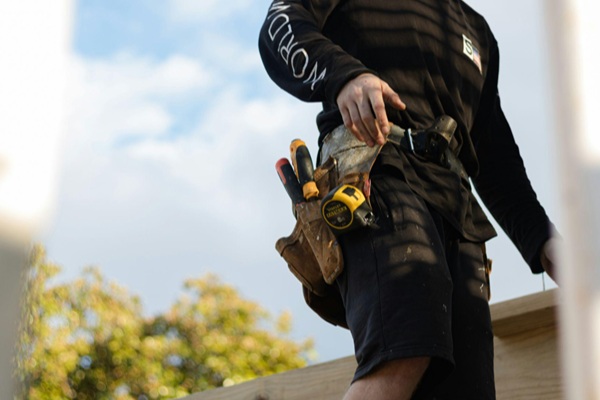How the toolbelt generation might save the trades
A serious skills shortage is plaguing Australia’s construction industry. Micro-builders feel the pinch most as they struggle to fill positions. Baby Boomers who once ran the business are hanging up their work boots wave by wave, yet the need for construction labourers continues. The heroes rising to the call of duty are called the Toolbelt Generation.
Who is the Toolbelt Generation?
The “Toolbelt Generation” is a moniker for the surge of young, tech-literate, socially aware workers entering the trades with a mindset more progressive than traditional labourers. They’re often first-generation tradies who see the profession not as a fallback but as an intentional career path. Like many of today’s younger employees, they put a high premium on flexibility, career progression and working environments that align with their values. The trades are highly attractive routes for such demands.
Unlike previous generations raised on the idea that a university degree is the only path to success, the Toolbelt Generation is rediscovering the trades as a viable, even desirable, career option. This mindset shift strengthens in light of rising Higher Education Contribution Scheme (HECS) debt, currently at 4.7%, artificial intelligence (AI) replacing job functions and the appeal of earning while learning.
Why they might be the solution
While governments and peak bodies continue to address systemic challenges, the Toolbelt Generation may offer the most organic and sustainable solution to the labour shortage. They bring energy, adaptability and modern skill sets to an industry undergoing rapid transformation.
For one, they’re digitally fluent. Construction is no longer purely manual. Drone surveying, Building Information Modelling (BIM), 3D printing and AI-driven project management are becoming everyday tools on site. The Toolbelt Generation is well-positioned to integrate these advancements seamlessly, having grown up in a technology-focused world.
In fact, 97% of Gen Z workers expect technology literacy to be a fundamental skill in any industry. A 2024 survey showed that 48% of employees had to learn new technologies to function properly. Older tradespeople will risk change fatigue if they have to learn new tools to stay relevant to their jobs, but younger tradies will have no problem adapting.
Second, they are mission-driven. Purposeful work drives younger staff who want to see the impact of their work so much that 44% of Gen Z workers turn down employers that don’t align with their values. This aligns well with the fundamental satisfaction of construction, building something tangible and lasting. Veteran employees sharing stories of completed projects and how they contributed to their communities have become a key recruitment tool.
Mentorship also plays a crucial role. Research shows that 47% of young Aussie workers are interested in being mentored. Experienced tradesmen who act as mentors can significantly increase apprentice retention, especially in highly niche industries. For example, neophyte hirelings who consult with geo-construction-specific professionals become more informed about the correct repair methods.
This is where micro-builders can have a distinct advantage. Their small teams allow for hands-on training, real-time feedback and stronger interpersonal relationships which is exactly what younger workers seek.
What they’re prioritising and why it matters
The Toolbelt Generation is reshaping the culture of construction with new priorities. Here are a few that stand out.
Safety as a culture, not a checklist
Younger employees have grown up in a world hyper-aware of workplace safety. They go beyond following procedures — they’re expecting psychological safety, inclusion and proactive risk mitigation, especially since the suicide rate for construction workers is 53% higher than in other industries. This pushes companies toward safer, more accountable work environments, especially as mental health becomes a bigger issue on jobsites.
Diversity and inclusion
Historically, trades have struggled with representation. But today’s new entrants expect to work in inclusive environments. Campaigns to encourage women and underrepresented groups into trades, like Tradeswomen Australia and NAWIC, have gained traction. A 2025 outlook reveals that women comprise 20% of the construction industry, a big step toward diversification.
Tech-enabled efficiency
This generation doesn’t just accept technology, they demand it. From mobile apps that track hours and job progress to prefabrication methods and artificial reality (AR) powered training tools, younger workers are pushing the industry to modernise.
Purpose-driven work
Sustainability and climate resilience are at the top of my mind. This aligns with the growing demand for green construction and energy-efficient builds, as the industry is a notorious belcher, churning 37% of the world’s total global emissions.
Younger workers are more likely to embrace low-carbon materials, renewable energy integrations and waste-reduction strategies because they are the industry’s future.
The opportunity for micro-builders
For micro-builders especially, the Toolbelt Generation represents an opportunity to bank on their enthusiasm. Their energy and tech-savviness can breathe new life into small operations. The key is meeting them where they are by offering flexible roles, emphasising learning pathways and building a culture that reflects their values.
Investing in mentorship, modernising workflows and partnering with schools or trade programs to host internships or workshops can turn the labour shortage from a crisis into a competitive advantage. Those who adapt fastest stand to benefit the most.
Rebuilding the trade one young worker at a time
The Toolbelt Generation won’t solve the trade shortage overnight. Still, they offer a pathway forward that’s both sustainable and promising. If the industry can nurture, guide and listen to them, this generation will save the trade simply by joining them.

